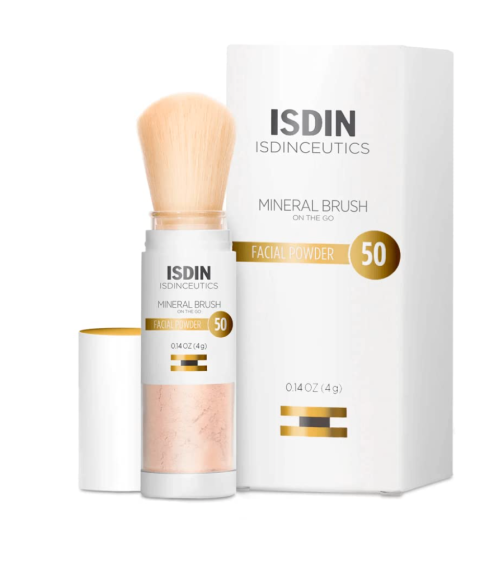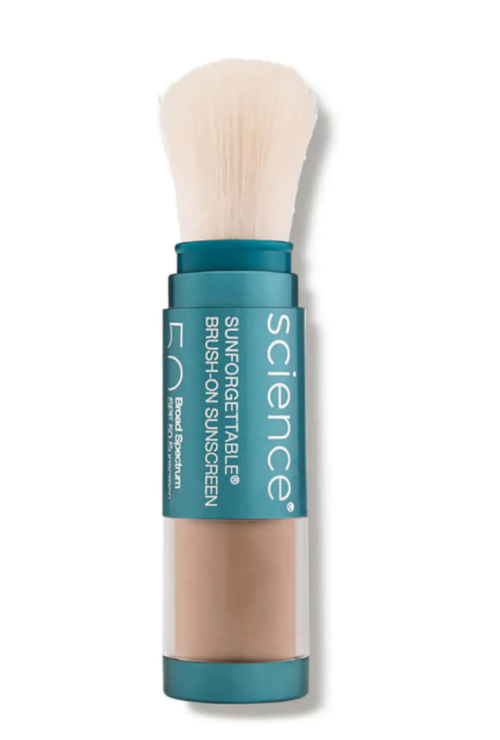Our editors independently select these products. Making a purchase through our links may earn Well+Good a commission
Hate To Break It to You, but All Those Buzzy Powder Sunscreens Aren’t As Effective as You Might Think
The amount of SPF powder you'd need to get the protection on the bottle is impossible to apply, even when using the best powder sunscreen.

Powder sunscreen is often recommended as a good option for touching up your protection throughout the day. If you’re wearing makeup, there’s no way you’re going to redo your face every two hours just to re-up with a liquid sunscreen, so powder SPF is really the only practical option. But, according to cosmetic chemist Michelle Wong, PhD, these products don’t provide nearly as much protection as you may think. The reason? The amount of powder you’d need to apply to actually get the amount of SPF listed on the bottle is impossible to apply.
Experts in This Article
board-certified dermatologist based in New York City
Sydney, Australia-based cosmetic chemist
“You need to cover your skin in enough UV-absorbing particles or molecules, otherwise too much UV can get through the gaps to your skin and cause damage,” says Dr. Wong. “The SPF of a product is tested using 2 milligrams per square centimeter applied very evenly to skin. If you apply less, you generally end up with lower protection and it’s a linear relationship—for example, if you apply half the amount, you end up with half the SPF. Powder doesn’t stick to skin very well, so it’s very difficult to apply the correct amount.”
In other words, if you’re applying an SPF 30 powder, at best, you’re getting SPF 15 protection. Realistically, though, it’s probably even less than that.
“Because skin is uneven, if you apply less than half the recommended amount, you usually end up with a lot less protection since it’ll be patchy and you end up with a lot of uncovered ‘hills’ on your skin,” says Dr. Wong. “This is a big problem with powder, since it tends to apply more unevenly than other product forms like lotions and sprays.”
Currently, the Food and Drug Administration (FDA) does not recognize powder SPFs as an authorized form of protection. Instead, the agency recommends sunscreen in forms like creams, sticks, butters, and gels. “The upcoming FDA monograph excludes powder sunscreens, even though Colorescience submitted data on their powder sunscreen to the FDA for consideration,” says Dr. Wong.
Elizabeth Kream, MD, a dermatologist and incoming fellow at the Laser and Skin Surgery Center of New York, says powder sunscreen shouldn’t be your sole form of protection. Start your routine with a liquid sunscreen and do your best to touch up with a powder sunscreen every two hours (because, yes—a touch-up with a powder is better than no touch-up at all).
“With powders, a downside is that it’s difficult to quantify exactly how much you applied,” says Dr. Kream. “Aim for two passes, moving the brush in small circles, for a total of about 60 seconds—making sure that powder is actually dispensing out of the container and on the brush bristles. I like to flick the brush before applying to ensure this.”
Plus, remember that SPF isn’t the only form of sun protection. “Seeking shade, wearing a hat or sunglasses, limiting exposure during peak sun hours, and wearing layers,” is also helpful, says Dr. Kream. Be sure to follow these tips regularly, but especially on days when powder sunscreen is your only form of SPF reapplication.
Dr. Kream recommends opting for a powder sunscreen with a higher SPF. You still won’t be getting the full SPF on the label, but getting part of SPF 50 is far better than getting part of SPF 30.
Shop the best SPF 50 powder sunscreens below

Isdin Mineral Brush Powder SPF 50 — $55.00
This Isdin sunscreen powder provides UVA, UVB, and blue light protection with titanium dioxide, zinc oxide, and iron oxides. It also includes mica to add a subtle glow to the skin.

Colorsience Sunforgettable Powder — $69.00
This is Dr. Kream’s favorite powder SPF. It uses zinc oxide and titanium dioxide to provide protection, plus iron oxides to provide blue light protection and hyaluronic acid powder for added hydration. It’s available in four shades.
Want to be the first to hear about the latest (and greatest) SHOP product drops, custom collections, discounts, and more? Sign up to have the intel delivered straight to your inbox.
Sign up for the Well+Good SHOP Newsletter
Get exclusive deals on wellness, beauty, fitness, and food products that have been hand-picked by our editors.
Got it, you've been added to our email list.










